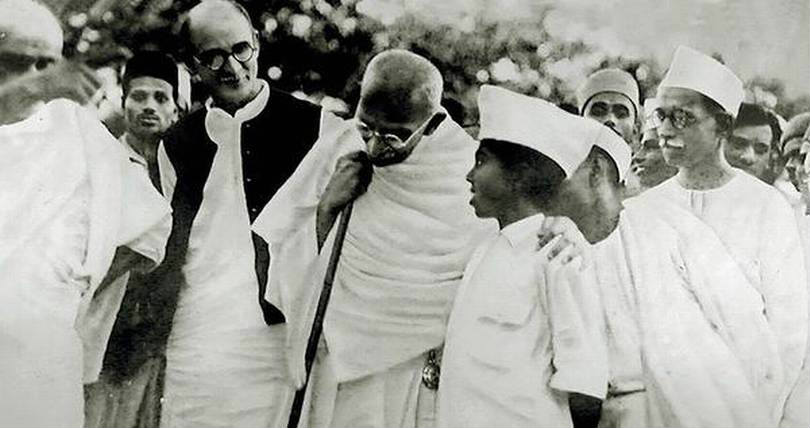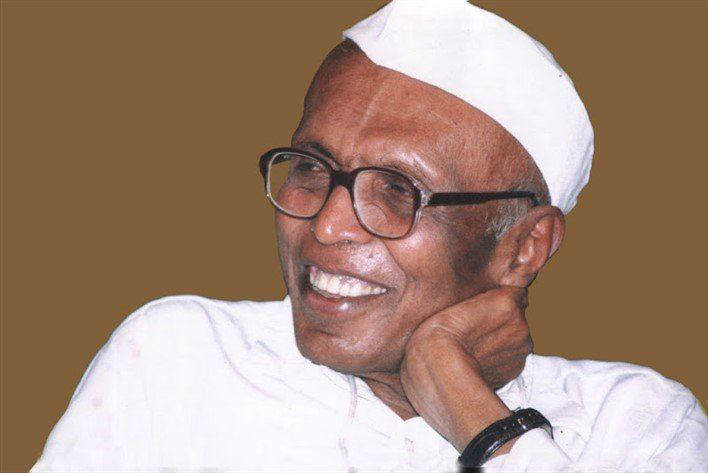WHEN LIFE TOUCHES LIFE – A REFLECTION IN THE 150TH YEAR OF GANDHI
Prof. Cheriyan Alexander

Here is a photograph from 1936 that I saw recently and that got me reflecting about the two marvellous lives that get connected here. Here we are in 2019, a special year, the 150th birth anniversary of MK Gandhi, and pictures like this are climbing out of the archives and into public media spaces. Good thing, too! They make it possible for people from a fresh new generation to acquaint themselves with the glories of our not so distant past.
The photo shows an informal moment in 1936 in Bangalore at the National School, Basavangudi, Bangalore. Gandhi is listening with attentiveness and affection to a 9th standard student of that school. His name is H. Narasimhaiah. The boy has two passions – science and India’s total freedom. Poorna Swaraj. That means complete independence. Not just from the British. But also from superstitions, ignorance, caste oppressiveness and corruption. Gandhi is his hero. What a beautiful moment the camera has frozen here!
Well, after this Gandhi went on with his campaign for independence and would go on to be martyred a few months after the great achievement of independence. 12 years after this picture. H. Narasimhaiah would go on to become one of India’s great scientists and educationists, professor and principal of National College, a distinguished Vice Chancellor of Bangalore University and a lifelong Gandhian, known for his simple lifestyle, his tremendous leadership in higher education and his unimpeachable integrity in high office.

Dr. H. Narasimhaiah
When he died in 2005, H.N (as everyone lovingly called him) left behind an impressive legacy of influence that would certainly have made his hero and role model proud. Take a look at that picture again. The elderly man enjoying the company of the young schoolboy, listening seriously to him and valuing the potential in him, thus motivating him to go boldly into the future and realise his great ideals.
How much do we value the young lives that rain past us in such profusion in this country, rich with the potential for glorious future revolutions that change their worlds for the better? The story of these two interconnected lives tell us how important and worthwhile it is to pay attention to the little ones and to honour their dreams and their ideals.
Persistence… for what?
It is over 11 years since Headstreams began. All through, the consistent desire has been to discover/innovate ways to enable participants to live meaningful lives. Facilitating the realization of their inherent potential to do this, has been the thread that runs through all our work – be it related to education, livelihoods or community development.
We are currently exploring how the practice of “Habits of Mind (HoM)” can best be introduced among children and youth. We enable this by providing safe facilitated learning environments underpinned by free choice and goal-setting paradigms.Our belief is that this can leverage capacities for problem solving, self-awareness and empathy. Constant systematic reflection is part of the process, and this is already yielding valuable affirmations, insights and challenges for us as facilitators.
Recently, while conducting a HoM session on the habit of “Persistence” in a Home for Boys (who had had a brush with the law), one of them asked, “What if we use our persistence to pursue illegal things?”
Later, discussing as a team, we were grateful that the boy was able to voice his thoughts, given the safe space that had been created for the children to freely share. We also realized that by sharing his thoughts,this boy was inviting us into a dialogue regarding a matter that was deeply personal and troubling for him. The sub-text of this question was a challenge: “Do you have anything meaningful to say/offer which can make me alter my thinking (or do you affirm it)?”
As part of that team discussion, we developed an ethical framework which could help anyone evaluate their choices or actions:
1) Will my action harm me today or in the long run (physically, mentally, emotionally,
socially, spiritually)?
2) Will my action harm others today or in the long run (on the same parameters)?
3) Would it make me proud if my child (or a loved one) made the same choices?
If the answer to any of these three was a NO, then it implied the need to rethink that choice or action.
Also important was that, while facilitating this ethical framework, one needs to remember that the realities of the participants are often highly complex and sometimes heart-breaking. As facilitators, an attitude of empathy and mercy is always preferred to one of passing ethical judgement. The challenge for us is to attempt holding on to our truth while empathetically dialoguing at the starting points that are offered.
It becomes crucial then that, as facilitators, we are able to read the sub-text of what is being said, to locate root concerns: safety, protection of loved ones, despair, etc. This helps to keep the conversation addressed to these concerns as the reference point,so that the dialogue does not degenerate into a “…but this is wrong and that is right” kind of framework. For example, if doing something illegal was the only way a child could think of, of helping one’s family, we could begin by recognising the desire to help, and commending the initiative to act for someone apart from themselves, before focusing on what other ways there may be to help one’s family. The dialogue would then become a starting point in identifying alternate ways to achieve one’s higher goals.
We would love to hear your thoughts and perspectives on this discussion, and also if you have any experiences to share on this topic. Looking forward to hearing from you!
Dr Naveen I. Thomas & Selena George
Co-Founders
PLAYFULNESS IN OLDER ADULTS
“It is in playing, and only in playing, that the individual child or adult is able to be creative and to use the whole personality, and it is only in being creative that the individual discovers the self.” – D.W.Winnicott
Older adults are an important part of the population, and according to Federal Interagency Forum on Aging Related Statistics the older adults are growing in numbers, living longer and are more active than the previous older generations. Research shows that majority of the studies focused on the health of older adults related to problems and diseases. Therefore few researchers have tired to look at the playful disposition of adults and its influence on their health. Yarnal, 2004 opined that playfulness also holds great potential for contributing to healthy aging. Elder, Johnson, and Crosnoe (2003) have also stressed that playfulness and having fun in later life may contribute to the maintenance of cognitive functioning, emotional growth, and healthy aging overall. Bartlett and Peel 2005 define this playfulness of older adults as a “process of adaptation to physical and psycho-social changes across the life course to attain optimal physical, mental and social well being in old-age.”
Guitard, Ferland, and Dutil (2005) identified few playful characteristics of older adults which are creativity, curiosity, pleasure, and a sense of humor. Playful older adults are mischievous, naughty, have a disposition towards being funny. Carver and White opine that these characteristics show the cognitive capacity of older adults.
Playful older adults are happy, joyful and enthusiastic in their approach to life which shows them being positive emotionally. Tugade and Fredrickson refer to this disposition of Playful older adults as being ‘psychologically upbeat’. Research studies by Miller and Ferland suggests that playful older adults can be a very novel and at their creative best too.
Research studies have proved that by encouraging playfulness in older adults it would help them to deal with everyday stressors, leads to healthy ageing, can balance between positive and negative emotional health as well good cognitive functioning.
Sources:
Yarnal and Xinyi QianOlder (2011), ‘Adult Playfulness An Innovative Construct and Measurement for Healthy Aging Research’, American Journal of Play, volume 4, number 1, pg 52-79.
By Dr Srividya K
